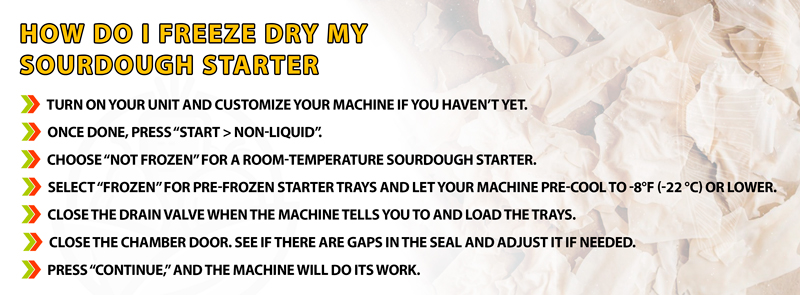Better Websites to own 2025
Jun 11, 2025

Sourdough bread is a tasty, healthy bread made with pure patience and love. Imagine ” feeding” a live dough daily to keep the yeast and beneficial bacteria alive. But those who make it say all that effort is worth it. Using it gives you delicious bread with a chewy crust and slightly tangy taste. But who has the time and patience to keep a sourdough starter alive these days? So if you got a good sourdough starter and you want to preserve it, then freeze-dry it!
Yes, you can. The key here is to be mindful of your temperature. Your sourdough starter is alive with wild yeast that thrives at warm temperatures. These microbes sleep and act sluggishly when it’s cold. But they’re very lively at 70°F-80°F (21°C-26°C), which is the typical temperature in most kitchens.
However, heat is one of the things that can kill a sourdough starter. Wild yeast dies at 140°F (60°C). While the dry temperature for Harvest Right freeze dryers is 125°F (51°C), others still experience sourdough starter kill.
To keep your starter alive, set the tray temperature to below 95°F-100°F (35°C-37°C). Others suggest going for 90°F-95°F (32°C-35°C). This can certainly extend your freeze-drying time, but the sacrifice is worth it.
Be careful also when you extend the freeze drying time and also defrosting. The longer the starter kit is exposed to high temperatures, the higher the chances of killing your starter.
Harvest Right freeze dryers are really excellent partners for your freeze-drying journey. You can let it run on default or customize the settings for better results. To set the temperature and keep your sourdough starter alive:

Pre-freezing is an option for your sourdough starter. Some throw in their starters when the freeze dryer’s open. For others, they let their starters “sleep” in the freezer as the machine finishes a different batch of food.
Pre-freezing is okay because sourdough starters can stay dormant in the deep freezer for 1 year. Also, drying out the starter is another way of putting the starter to sleep. So it wouldn’t hurt to give your dough a good kickstart on dormancy when you freeze it.
When you pre-freeze, use the same trays in which you’ll freeze-dry the starter. Lining the trays with a silicone mat will help make taking out the sourdough starter easier. Although parchment paper works, it moves around a lot when you spread the dough.
Whether or not you pre-freeze, make sure that the height of the dough doesn’t exceed or even reach the lip of the tray. A thick starter takes longer to freeze dry, so spread it as thin and evenly as possible.
Once your trays and unit are ready, it’s time to start freeze-drying.
After the freeze-drying process, you should have a thin, flakey, dry, and crumbly product. If some areas still feel cold and soft, put the trays back for an extra dry time of 1-2 hours.
Since your drying temperature is lower, the drying time for your dough can take up to 4 days. So plan this last on your lineup to keep your freeze-drying schedule uninterrupted.
You can break your freeze-dried dough into small flakes, but these take longer to rehydrate. You can pulverize the FD starter using a blender or Magic Bullet, then store the powder in Mason jars or Mylar bags. Remember to throw in 1-2 of the 300cc oxygen absorbers to further extend your freeze-dried sourdough starter’s shelf life.
For storing, you must keep the room temperature stable below 72°F (22 °C). Remember that heat is your starter’s leading killer, so keep it cool and dry as much as possible.

For reactivating freeze-dried sourdough starter, you need to consider the following:
Use a clean jar and chlorine-free water to reactivate your freeze-dried sourdough starter. You should do this by weight for a more active measurement. Mix 10g of FD sourdough starter and 40g of warm water. Mix them well, and let the mixture stand for 2 hours with occasional stirring. Then add 40g grams of flour. Cover lightly to allow it to circulate, and set your container in a moderately warm location.
After 24 hours, you should see some bubbling action going on. Take 20g of your starter and discard the rest. Then add 20g of water and 20g of water, stirring well to help air circulate through the mix. The amount of water you’ll add will depend on the humidity level. You might want to add more or less to get that gloopy consistency.
Cover lightly once again and let it sit for another 24 hours.
More bubbles will show! Take 20g of your starter dough again and discard the rest. This is also the day when your sourdough starter will rise. After adding the same amount of water, mark the level of the dough and cover lightly.
Your dough should have that smell of yeast like you stepped inside a bakery. Repeat the process, making sure the flour is pretty smooth. Your starter dough should be 1/3 full by now. Your dough will rise and fall throughout the process, so enjoy the show.
If everything goes well, your starter’s now actively bubbling and breathing. You’re ready to bake with it if it rises to double its size and doesn’t deflate.
Freeze-dried sourdough starters have live, yet dormant beneficial yeast and bacteria. Treat it with care, and it will last you for years. It’s certainly a challenge to make, from creating, to freeze-drying, and reactivating. But all that hard work will help you create delicious bread and even pizza that will satisfy and comfort your family for years to come.
There’s a tradition of naming your sourdough starter to make it really come alive. So please share what you would call yours in our comment section!
This is pretty much an advanced stage of food preparation and preservation. We’re getting ready to make videos like this to give you a better visual of what to do and expect. Please subscribe to our YouTube Channel and hit the bell to get notified when we upload our videos.